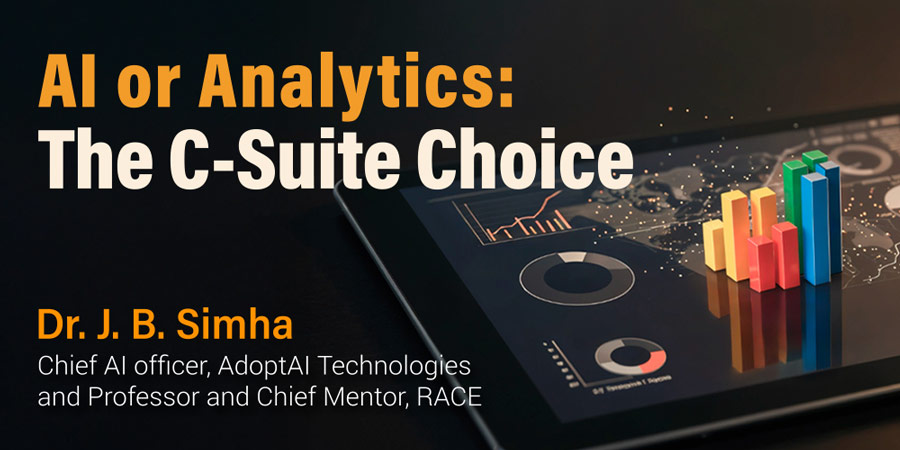What the C-Suite Really Wants

From breaking down the real difference between AI and analytics to why most organizations get stuck in pilots and fail to drive adoption, this session offered rare, unfiltered insights that most boardrooms whisper but never say aloud.
💡 Stat to Think About: According to IDC, worldwide spending on AI will reach $500 billion by 2027, but over 60% of AI models still never make it to production.
So what’s going wrong? And more importantly — how can professionals and enterprises get it right?
This blog captures the complete story — as told in the webinar — rich with real-world analogies, advice for working professionals, and a future-forward look at AI’s role in business.
Meet the Visionary: Dr. J.B. Simha

Few names resonate in the enterprise AI and analytics space like Dr. J.B. Simha. With over 25 years of experience in building AI products and enterprise systems, Dr. J.B. Simha has not only led large-scale AI transformations but also played a key role in enabling C-level executives to understand the why behind AI — not just the how.
As he succinctly put it during the session:
“We don’t need models. We need results.”
That one sentence set the tone for the entire webinar — one that explored not just the buzz but the business value of AI and analytics.
What C-Level Executives Really Want from AI & Analytics
When it comes to the world of data, analytics, and emerging technologies, there’s often a gap between what’s technically possible and what decision-makers actually care about. As Dr. J.B. Simha emphasized right at the start, “Technology is not the problem. Adoption is.”
And he drove home a strong point: “CEOs don’t care about deep learning layers. They care about churn, revenue, and risk.”
He went on to explain that AI and Analytics are not interchangeable — and that understanding the distinction is the key to solving real business problems.
AI vs. Analytics: A Strategic Difference
While analytics helps you understand what happened and why, AI goes a step further — predicting what could happen and recommending what to do next. Analytics reflects; AI responds. One drives insight, the other drives action.
Analytics is about reasoning and insight. AI is about action and automation.
In his words: “Analytics is like a mirror. It tells you what’s happening. But AI? That’s a steering wheel. It helps you move forward.”
He also reminded the audience that ERP, CRM, SCM systems are only complete when layered with analytics and then AI. These business systems generate tons of data — but without analytical intelligence, they remain just databases.
“ERP, CRM, SCM — all of these systems need analytics as their next stage. Only then does AI make sense.”
Without analytics, they are just data repositories. And without AI, insights don’t become action.
It’s Not Just About the Known — It’s About Exploring the Unknown
Dr. Simha took the audience through a layered approach to analytics — moving from known questions with known answers to exploring unknown causes and outcomes. He emphasized how analytics can help identify invisible patterns that intuition alone cannot capture.
In one case he shared, a simple shift from gut-feel decision-making to data-driven procurement strategies saved a large retail firm millions.
It’s not just about predictions — it’s about understanding.
- Why is a customer leaving?
- What is causing inventory delays?
- When is the right time to launch a product?
When analytics helps uncover what you didn’t know, that’s when it becomes transformational.
The Skills Gap: Why Tech Alone Isn’t Enough
A key insight from the session was that technology skills alone are insufficient in the current business landscape. Organizations need professionals who understand not just the tech stack, but also functional and business nuances.
This alignment of technical and business literacy is what makes an AI professional truly valuable.
What Are Enterprises Actually Looking For?
From Dr. J.B. Simha’s perspective — gained through years of industry leadership — C-level executives don’t care about the model’s architecture or how deep your neural net is. “They care about outcomes. Period.”
In short, Models are not what we need. Results are what we need.
Career Roles in AI & Analytics: What’s Hot, What’s Coming
Dr. J.B. Simha laid out a clear roadmap of evolving roles in space. Some of the most in-demand positions today include Data Analyst, AI Product Owner, ML Engineer, AI Architect, and Data Translator – a key liaison between business leaders and tech teams.
He emphasized the increasing importance of data storytelling and decision science. It’s not enough to build a dashboard; professionals need to contextualize and communicate insights that drive action.
Fast-Tracking Careers: The Role of the Right Master’s Program
One of the most practical takeaways from the webinar was Dr. J.B. Simha’s emphasis on choosing the right academic program. He pointed out how many professionals get stuck between certifications and piecemeal upskilling without gaining a holistic understanding.
“The right program doesn’t just teach you tools. It shapes you into a decision-maker.”
Final Thoughts: From Awareness to Action
As the session wrapped up, it was clear that Dr. J.B. Simha’s message wasn’t just about the future of AI and Analytics — it was about building careers that matter, and making technology work for business.
“You don’t need to be a data scientist to make a difference in analytics. But you do need to understand how decisions are made using data.”
Turn insights into impact — explore future-ready programs like the M.Sc. in Business Analytics and M.Sc. in Artificial Intelligence at RACE, REVA University, where ambition meets action and data drives real-world leadership.



